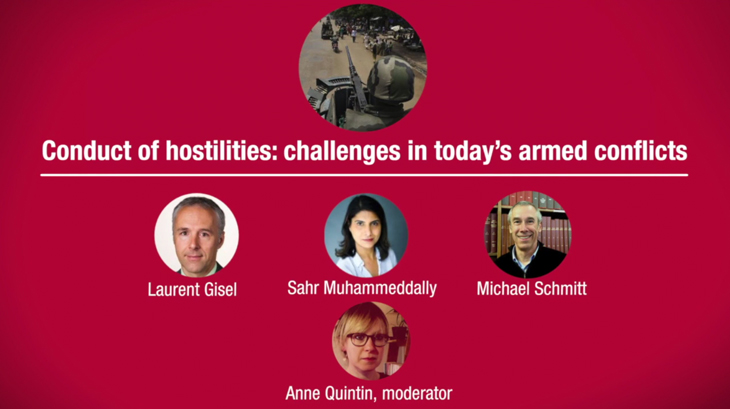Conduct of hostilities: Challenges in today’s armed conflicts
The Advanced IHL Learning Series are addressed to lecturers and trainers who wish to be abreast of the latest developments in international humanitarian law (IHL) and other related areas. The series help lecturers strengthen their grasp of topical issues and gives them access to teaching resources, thereby enabling them to introduce these topics or issues in the courses or training sessions that they run.
The Advanced IHL Learning Series combines theory and practice; it makes use of videos, reading materials and various other teaching tools. Many of the resources are taken from the 2015 edition of the Advanced Seminar in IHL for University Lecturers and Researchers. The videos feature lectures by speakers at the seminar, and discussions between them and participants. The opinions expressed by the lecturers in the series are theirs alone, and not necessarily shared by the ICRC.
Introduction to "Conduct of hostilities: challenges in today's armed conflicts"
International humanitarian law governing the conduct of hostilities regulates and limits the methods and means of warfare used by parties to an armed conflict. It aims to protect civilians and civilian objects by striking an appropriate balance between legitimate military action and the humanitarian objective of reducing human suffering, particularly among civilians. This law only applies to "hostilities", meaning the collective resort by the parties to an armed conflict to means and/or methods of injuring the enemy. Indeed, there are situations where the use of force in armed conflicts is not subject to these rules but to the rules governing law-enforcement operations. Respect for the rules governing hostilities has to be assessed based on the information available to the commander at the time and not ex post facto. The relevant standard test to examine whether international law on the conduct of hostilities is respected is that of the "reasonable commander": an individual making reasonable use of all relevant information reasonably available at the time. The main principles governing the conduct of hostilities are the principles of distinction, proportionality and precautions in attack.
The principle of distinction requires that the parties to the conflict must at all times distinguish between the civilian population and combatants and between civilian objects and military objectives, and only direct their attacks at combatants and military objectives. Civilians are persons not belonging to armed forces. More specifically, for non-international armed conflicts, civilians are persons not belonging to State armed forces or to any organized armed group. Civilian objects are defined as any objects that cannot be considered as military objectives.
Under IHL, civilians are entitled to protection against attack "unless and for such time as they take a direct part in hostilities" (see, Interpretative Guidance on the Notion of Direct Participation of Hostilities under International Humanitarian Law).
Indiscriminate attacks are also prohibited. Article 51(4) of Additional Protocol I describes three types of indiscriminate attacks: those which are not directed at a specific military objective; those which employ a means or method of combat which cannot be directed at a specific military objective; or those which employ a means or method of combat the effects of which cannot be limited, as required by this Protocol; such attacks are, therefore, of a nature to strike military objectives and civilians or civilian objects without distinction.
The principle of proportionality prohibits attacks which may be expected to cause incidental loss of civilian life, injury to civilians, damage to civilian objects, or a combination thereof, which would be excessive in relation to the concrete and direct military advantage anticipated. When engaging in warfare, there can be a factor of uncertainty, which is addressed in treaty law: for example, Article 50(1) and 51(5)(b) of Additional Protocol I, which establish a presumption of civilian status in case of doubt as to whether a person is a civilian or whether an object normally dedicated to civilian purposes is used to make an effective contribution to military action. How to factor uncertainty into decisions related to the conduct of hostilities is an important challenge when applying the law in the middle of the fighting.
The principle of precautions in attack is enshrined in Articles 57 and 58 of Additional Protocol I. The "constant care" obligation contained in article 57 has to extend to all military operations, including military operations other than attacks (on the notion of "military operations" however, see the ICRC's Commentary on AP I, paragraph 2191 in fine). More specifically, when planning or deciding upon an attack, a commander has to take all feasible precautions: to verify that the target is a military objective; to choose the means and methods of warfare with a view to avoiding or at least minimizing incidental civilian harms; and to refrain from attacks where such harm to civilians and civilian objects would be excessive compared to the military advantage, etc. Finally, during the execution of the attack, the principle of precautions ultimately requires cancelling or suspending an attack when it becomes apparent that it would not comply with the principles of distinction or proportionality. Hence these principles and rules must be respected by commanders and soldiers at every phase of the attack. IHL also requires that the party that may be affected by enemy attack take precautionary measures. Thus, the parties to a conflict must take all feasible precautions to protect the civilian population and civilian objects under their control against the dangers resulting from military operations.
It is important to remain practical when teaching the rules of IHL governing the conduct of hostilities. Lecturers should master the law and understand how armed conflicts are fought and decisions made on the ground. Teaching through real-life examples, such as case studies, is key to fostering a better understanding of how the rules governing the conduct of hostilities are applied in practice. Nevertheless, lecturers should manage their students' expectations, recognizing that they will not receive the level of in-depth training a military commander will.
Learning objectives
At the end of the series, lecturers will be able to:
- define the principle of distinction and the prohibition of indiscriminate attacks
- explain the principle of proportionality
- describe the precautionary measures a belligerent has to take to minimize civilian harm
- break down the uncertainty in the identification of military objectives.
Structure of the course
1. Required and suggested reading: Before watching the videos, lecturers and trainers are invited to familiarize themselves with the topic by working their way through the required and suggested reading.
2. Videos: The entire session can then be watched at once, or by chapter, depending on the need and specific interest of each user.
3. Teaching tools: ICRC teaching tools on IHL, as well as specific, ready-to-use teaching materials on humanitarian principles, are available online free of charge. Lecturers are encouraged to use them to discuss contemporary humanitarian issues in their course or training module.
4. Further reading and resources: Lecturers and humanitarian professionals are encouraged to explore the topic further via additional resources (e.g. articles and blog posts) on IHL, humanitarian principles and related matters. Researchers may wish to use these materials as sources for their research projects in this area.
Speaker biographies
Laurent Gisel, ICRC
Laurent Gisel has been working for the ICRC since 1999. From 1999 to 2005, he carried out assignments in Israel and the occupied territories, Eritrea, Afghanistan and Nepal. From 2005, he served as diplomatic adviser to the ICRC president. Since 2008, he works in the ICRC's Legal Division. As legal adviser to Operations from 2008 to 2012, he covered Iraq and Afghanistan. He is currently senior legal adviser in the Thematic Legal Advisers' Unit. Prior to joining the ICRC, Laurent worked at the Public and Administrative Law Court of the Canton of Vaud. He holds a degree in law from the University of Geneva and a master's degree in international law from the Graduate Institute of International and Development Studies.
Sahr Muhammedally, Center for Civilians in Conflict
Sahr Muhammedally is a director at the Center for Civilians in Conflict. She manages research and policy advocacy for civilian protection and harm mitigation, and advises governments and weapon bearers on civilian protection during all phases of operations. She has worked for over 15 years in the fields of armed conflict, human rights and counterterrorism, and has conducted research in Afghanistan, China, Indonesia, Iraq, Malaysia, Pakistan, Syria and Yemen. Prior to joining the Center for Civilians in Conflict, she was a consultant with Human Rights Watch working on South and South-East Asia, and was a senior associate at Human Rights First. She practised law in New York with Gibbons PC and has been a consultant with the American Civil Liberties Union, Human Rights in China and the International Rescue Committee. She is a graduate of Mount Holyoke College (BA in Politics) and Brooklyn Law School (JD cum laude).
Michael Schmitt, Exeter University
Michael Schmitt is a professor of public international law at Exeter Law School. He is also the Charles H. Stockton Professor at the United States Naval War College, the Francis Lieber Distinguished Scholar at the United States Military Academy at West Point, and Senior Fellow at the NATO Cooperative Cyber Defence Centre of Excellence. He served 20 years in the United States Air Force as a judge advocate, specializing in operational and international law.
Reading material
Required reading
- International Law Association Study Group, The Conduct of Hostilities and International Humanitarian Law: Challenges of 21st century Warfare, 2017.
- Center for Civilians in Conflict, Civilian Protection in the Current Mosul Campaign, February 2017.
- ICRC, International Expert Meeting: The Principle of Proportionality in the Rules Governing the Conduct of Hostilities under International Humanitarian Law, 2018.
- Bruno Demeyere and Tom Ruys, "Means and methods of warfare" in Jan Wouters, Philip De Man and Nele Verlinden, Armed Conflicts and the Law, Intersentia, 2016, pp. 305–342.
- Knut Doermann, "Obligations of international humanitarian law", Military and Strategic Affairs, Vol. 4, No. 2, 2012, pp. 11–23.
- Laurent Gisel, "The use of explosive weapons in densely populated areas and the prohibition of indiscriminate attacks", in Conduct of Hostilities: The Practice, the Law and the Future, 37th Round Table on Current Issues of International Humanitarian Law, San Remo, 2014, pp. 100–112.
- Nils Melzer, International Humanitarian Law: A Comprehensive Introduction, ICRC, Geneva, 2016, pp. 77–125.
- Sahr Muhammedally, "Minimizing civilian harm in populated areas: Lessons from examining ISAF and AMISOM policies", International Review of the Red Cross (IRRC), No. 901, 2016, pp. 225–248.
- Jean-François Quéguiner, "Precautions under the law governing the conduct of hostilities", IRRC, No. 864, 2006, pp. 793–821.
- How Does Law Protect in War? website, see glossary entry: Conduct of hostilities.
Suggested reading
- ICRC, International Humanitarian Law and the Challenges of Contemporary Armed Conflicts, section VII on the means and methods of warfare, 2015, pp. 38–59.
- ICRC, International Humanitarian Law and the Challenges of Contemporary Armed Conflicts, section V on the means and methods of warfare, point 3 on direct participation in hostilities, 2011, pp. 42–45.
- ICRC, International Humanitarian Law and the Challenges of Contemporary Armed Conflicts, section IV on the conduct of hostilities, 2007, pp. 12–20.
- ICRC and College of Europe, Urban Warfare, 16th Bruges Colloquium on Urban Warfare, 15–16 October 2015, pp. 109-137.
- Geoffrey Corn, "War, Law, and the Oft Overlooked Value of Process as a Precautionary Measure", Pepperdine Law Review, Vol. 42, No. 3, 2015, pp. 419–464.
- Geoffrey Corn and James A. Schoettler, "Targeting and civilian risk mitigation: the essential role of precautionary measures", Military Law Review, Vol. 223, Issue 4, 2015, pp. 785–842.
- Yoram Dinstein, The Conduct of Hostilities under the Law of International Armed Conflict, 3rd edition, Cambridge, Cambridge University Press, 2016.
- Nathalie Durhin, "Protection civilians in urban areas: a military perspective on the application of international humanitarian law", IRRC, No. 901, 2016, pp. 177–199.
- Camille Faure, "Focus sur le principe de distinction", in The Additional Protocols 40 Years Later: New Conflicts, New Actors, New Perspectives, 40th Round Table on Current Issues of International Humanitarian Law, San Remo, 2017, pp. 59–67.
- Robin Geiss and Michael Siegrist, "Has the armed conflict in Afghanistan affected the rules on conduct of hostilities?", IRRC, No. 881, 2011, pp. 11–46.
- Laurent Gisel, "The relevance of revenue-generating objects for the notion of military objective" in ICRC and College of Europe, The Additional Protocols at 40: Achievements and Challenges, 18th Bruges Colloquium, 19–20 October 2017, pp. 139–150.
- Ian Henderson, The Contemporary Law of Targeting: Military Objectives, Proportionality and Precautions in Attack under Additional Protocol I, Leiden, Nijhoff, 2009.
- Agnieszka Jachec-Neale, The Concept of Military Objectives in International Law and Targeting Practice, London/New York, Routledge, 2015.
- Nils Melzer, Interpretative Guidance on the Notion of Direct Participation in Hostilities under International Humanitarian Law, ICRC, Geneva, 2009.
- Sahr Muhammedally, "Lesson from Mosul: How to reduce civilian harm in urban warfare", Just Security, July 2017.
- Noam Neuman, "Considering the principle of precautions", in The Additional Protocols 40 Years Later: New Conflicts, New Actors, New Perspectives, 40th Round Table on Current Issues of International Humanitarian Law, San Remo, 2017, pp. 74–82.
- Isabel Robinson and Ellen Nohle, "Proportionality and precautions in attack: The reverberating effects of using explosive weapons in populated areas", IRRC, No. 901, 2016, pp. 107–147.
- Marco Sassòli and Anne Quintin, "Active and passive precautions in air and missile warfare", Israel Yearbook of Human Rights, Vol. 44, 2014, pp. 69–123.
- Pnina Sharvit Barush and Noam Neuman, "Warning civilians prior to attack under international law: Theory and practice", International Law Studies, Vol. 87, 2011, pp. 359–412.
- Michael N. Schmitt, "Precision attack and international humanitarian law", IRRC, No. 859, 2005, pp. 446–466.
- Michael N. Schmitt and Eric Widmar, "The law of targeting", in Paul A. L. Duscheine, Michael N. Schmitt and Frans P. B. Osinga, Targeting: The Challenges of Modern Warfare, Berlin/Heidelberg, Springer, 2016, pp. 121–145.
- Eric Talbot Jensen, "Precautions against the effects of attacks in urban areas", IRRC, No. 901, 2016, pp. 147–177.
Watch the videos
The course is divided into several sessions. Click on a title to watch the video.
- 1. Outline of the session
- 2. Applying the principle of distinction in today's armed conflicts
- 3. Applying the principle of precautions in today's armed conflicts
- 4. Applying the principle of proportionality in today's armed conflicts: Understanding uncertainty in targeting
- 5. Conclusions and perspectives
Teaching tools on conduct of hostilities
- ICRC, IHL in Action: Respect for the Law on the Battlefield, case study: Afghanistan, Tactical Directive on the Employment of force.
- ICRC, IHL in Action: Respect for the Law on the Battlefield, case study: Afghanistan, Implementation of a Civilian Casualty Tracking Cell.
- ICRC, IHL in Action: Respect for the Law on the Battlefield, case study: Mali, France's Operation Serval, Minimizing Civilian Casualties.
- How Does Law Protect in War? website, see case study: ICTY, The Prosecutor v. Gotovina and Markac.
- How Does Law Protect in War? website, see case study: Iraq, The Battle for Mosul.
- How Does Law Protect in War? website, see case study: Germany, Aerial Drone Attack in Mir Ali/Pakistan.
- How Does Law Protect in War? website, see highlight: War in Cities.
- ICRC, Advanced IHL Learning Series, "The use of explosive weapons in populated areas".
- ICRC, "Explosive weapons in populated areas: The consequences for civilians", video.
- ICRC, "The basic rules and principles of IHL", e-learning.
- ICRC, Online training on the Law of Armed Conflict for non-State Actors.
Further reading and resources
- William H. Boothby, The Law of Targeting, Oxford, Oxford University Press, 2012.
- Shannon Bosch, "The International Humanitarian Law Notion of Direct Participation in Hostilities – A Review of the ICRC Interpretative Guide and Subsequent Debate", Potchefstroom Electronic Law Journal, 2014, pp. 999–1046.
- Scott Graham, "The non-combatant casualty cut-off value: assessment of a novel targeting technique in operation inherent resolve", International criminal law review, 2018, pp. 655–685.
- Tetyana (Tanya) Krupiy, A Toolbox for the Application of the Rules of Targeting, Newcastle upon Tyne, Cambridge scholars publishing, 2016.
- Nils Melzer, "Keeping the balance between military necessity and humanity: A response to four critiques of the ICRC's Interpretative Guidance on the notion of direct participation in hostilities", NYU Journal of International Law and Politics, 2010, pp. 831-916.
- Michael N. Schmitt, "On target: precision and balance in the contemporary law of targeting", Journal of National Security Law and Policy, Vol. 7, 2014, pp. 379–409.
- Paul Scharre, "Human judgment and lethal decision-making in war", Humanitarian Law and Policy blog, 2018.
- Jeroen Van den Boogaard, "Proportionality and autonomous weapons systems", Journal of International Humanitarian Legal Studies, Vol. 6, Issue 2, 2015, pp. 247–283.
- Kenneth Watkin, "Military advantage: A matter of "value", strategy, and tactics", Yearbook of International Humanitarian Law, Vol. 17, 2014, pp. 277–364.




